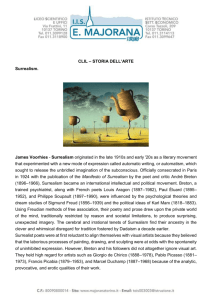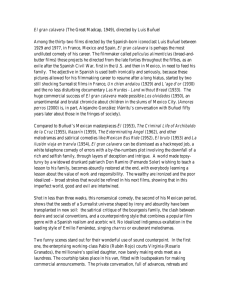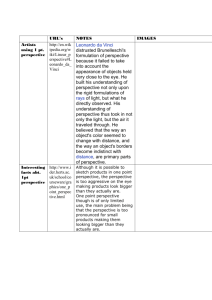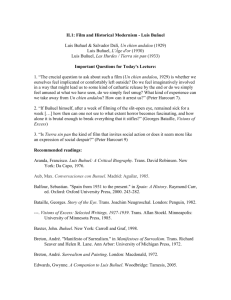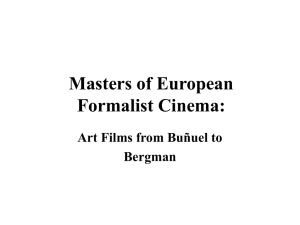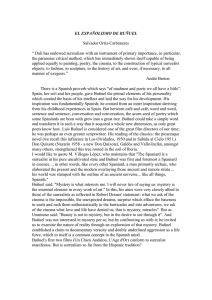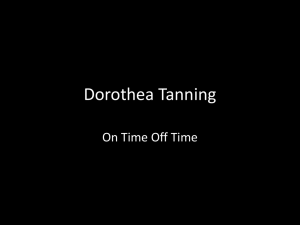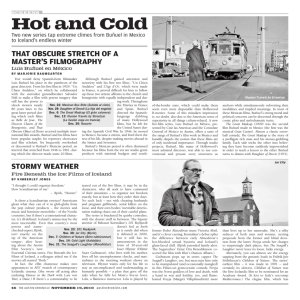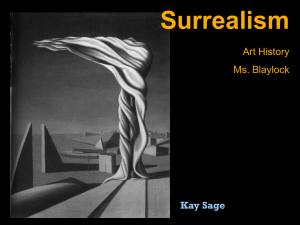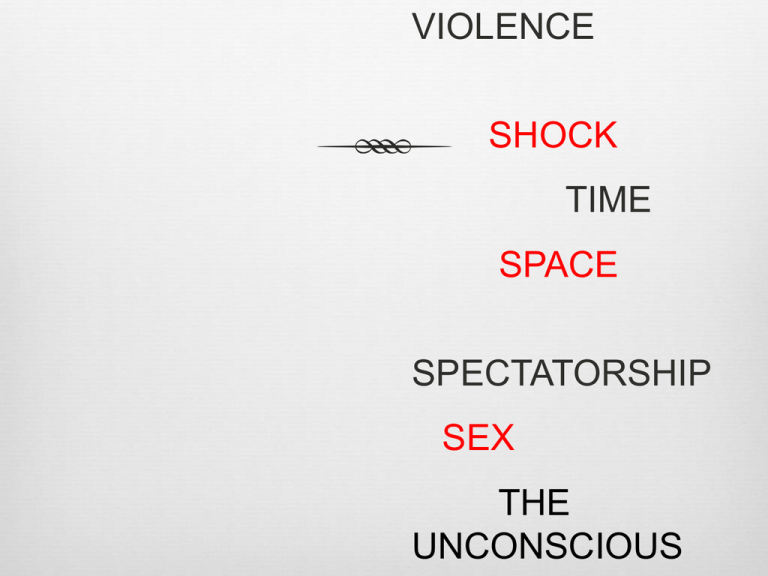
VIOLENCE
SHOCK
TIME
SPACE
SPECTATORSHIP
SEX
THE
UNCONSCIOUS
“Dalí’s name became increasingly dissociated
from the movie, as is illustrated by the absence
of the painter’s name on the cover of the English
edition of the script” (López 35).
Salvador Dalí, El gran masturbador (1929)
El rostro principal = Dalí
los ojos cerrados = el inconsciente
Luis Buñuel
(portrait by Salvador Dalí)
Un perro andaluz:
the connection with Federico García Lorca
“Cuando en los años treinta estuve en Nueva York,
Ángel del Río me contó que Federico, que había estado
también por allí, le había dicho: <<Buñuel ha hecho
una mierdecita así de pequeñita que se llama Un
perro andaluz; y ese perro andaluz soy yo.>>”
- Luis Buñuel
– Georges Bataille
“I have discarded clarity as
worthless. Working in darkness, I
have discovered lightning”
– André Breton
Photograph by Man Ray (1928)
The first Surrealist Manifesto (1924)
– André Breton
“We are still living under the reign of logic: this, of
course, is what I have been driving at. But in this day
and age logical methods are applicable only to solving
problems of secondary interest.”
“Surrealism does not allow those who devote
themselves to it to forsake it whenever they like. There
is every reason to believe that it acts on the mind very
much as drugs do; like drugs, it creates a certain state
of need and can push man to frightful revolts.”
The second Surrealist Manifesto,
André Breton (1929)
“It is living and ceasing to live which are
imaginary solutions. Existence is elsewhere.”
“The simplest Surrealist act consists of
dashing down into the street, pistol in hand,
and firing blindly, as fast as you can pull the
trigger, into the crowd.”
Ceci n’est pas un pipe (1928-1929)
– Rene Magritte
René
Magritte
La Durée
poignardée
(Time
Transfixed)
1938
Rene Magritte, El espejo falso (1935)
THE EYES (DON’T)
HAVE IT
“The faithful alliance between the eye and the body came under
severe attack with the oncoming of the first world war. The effects of
trench warfare on peoples’ perceptions caused them to question and
reevaluate the confidence they had once put in their sense of vision.
The experience of trench warfare was characterized by confusion due
to not being able to see the enemy, indistinguishable shadows, gasinduced haze, and sudden spurts of blinding light. […] The directive
of this movement [Surrealism] was to restore a unified vision that
would coincide with what was was desired for the emerging postwar
society”
– Martin Jay, “The Disenchantment of the Eye: Surrealism and the
Crisis of Ocularcentrism”
I
DO
NOT
SEE
THE
HIDDEN
(WOMAN)
IN
THE
FOREST
15 / 12/ 1929
BUÑUEL AND SURREALISM
“Surrealism taught me that life has a moral
meaning that man cannot ignore. Through
surrealism I discovered for the first time
that man is not free. I used to believe that
man’s freedom was unlimited, but in
surrealism I saw a discipline to be followed.
It was one of the great lessons of my life, a
marvelous, poetic step forward”
– Luis Buñuel (qtd. in Harcourt 3).
France: 1925-1931
Spain: 1932-1937
USA: 1938-1945
Mexico: 1946-1965
Spain: 1961; 1970
France: 1963-1977
"an iconoclast, moralist, and
revolutionary who was a leader of
avant-garde surrealism in his youth
and a dominant international movie
director half a century later”
- NYTimes obituary (1983)
HISTORICAL CONTEXT:
SPAIN:
1886 (1902) -1931: King Alphonse XIII (“La Restauración”)
1923-1930: DICTATORSHIP – Miguel Primo de Rivera
1931-1936: The Second Republic
1936-1939: The Spanish Civil War (military rebellion after the 1936 election)
1939-1975: Dictatorship (Francisco Franco)
WORLDWIDE:
1914-1918: WWI (“la Gran Guerra”)
Allied Powers
Central Powers
Neutral countries
Las Hurdes y su posición geográfica
La Alberca
(Salamanca)
Las Hurdes
(Extremadura)
Historical Details (Sebastian Balfour)
1923-1930: ‘Prime Minister’ : Miguel Primo de Rivera
1931-1936: The Second Republic
1936-1939: Spanish Civil War
“For its sympathizers […] the coming of the Republic heralded a
historic shift in power and wealth from a small minority to the
vast majority of society. […] The new government was thus
entrusted with a huge burden of expectations” (Balfour 243).
THE SECOND REPUBLIC IN SPAIN
“Two overriding objectives:
1.
transform a corrupt and unrepresentative political system into a pluralist
democracy
2.
carry out from above a programme of reforms to modernize Spanish
society” (Balfour 245).
The problem with (social) realism?
“Luis Buñuel’s documentary Las Hurdes: Tierra sin pan
(1933), was commissioned by the first left-wing
government of the Republic, but caused it only
consternation. As D’Lugo observes: ‘the film’s depiction
of poverty, hunger, and social backwardness of the rural
Spanish region of Las Hurdes was perceived as
offensive to the Spanish nation’. He adds ‘given the
shift to the right in the general elections of 1933, there
seemed very little chance that the film or its director
would receive any support from official Spain’” - Núria
Triana-Toribio (Spanish National Cinema 27)
La boca abierta: infección e interrupción
Luis Buñuel, Las Hurdes
Jacques-André Boiffard, “Bouche”
(Documents)
“Luis Buñuel, Spaniard and Surrealist”
“On the surface, the film (Tierra sin pan) attacks
the existence of misery; more deeply it
denounces the misery of existence…” Yet
finally, once we have got over the effect of the
film and paid tribute to the power of its steady
passion, a disquieting question might suggest
itself to us? For what is our relation to all of
this? Indeed, what is Buñuel’s? Is Tierra sin pan
the kind of film that invites social action or
does it seem more like an expression of social
despair?” (Peter Harcourt 9).
Georges Bataille, “The Mouth”
Jacques-André Boiffard, Documents

